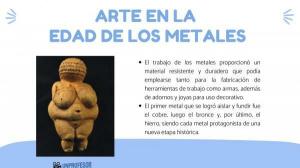Pop Art: Featured Artists and Their Works
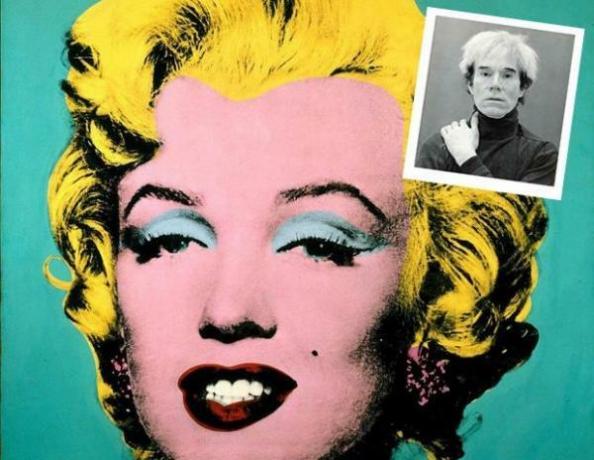
Image: Who
In this lesson from a TEACHER, Pop Art: Featured Artists and Their Works, we will dedicate ourselves to its creators, to the creators of the most groundbreaking and significant visual movement of the twentieth century that, as already we noted earlier, they created images recorded in the collective imagination as the very visual representation of a epoch.
Andy Warhol, Roy Lichtenstein, Claes Oldenburg, among others, they achieved what a few years earlier was impossible, democratize art. Such was the scope of its dissemination that his creations have reached the Moon and for that reason, and so many other merits, in this lesson we will devote all our attention to them.
Index
- Richard Hamilton (1922 - 2011)
- Jasper Johns (1930)
- Robert Rauschenberg (1925 - 2008)
- Roy Lichtenstein (1923-1997)
- Tom Wesselman (1931 - 2004)
- Claes Oldenburg (1929)
- David Hockney (1939)
- Allen Jones (1937)
- Andy Warhol
Richard Hamilton (1922 - 2011)
We begin by talking about the prominent artists of Pop Art and his works by talking about Richard Hamilton. He was a British artist and designer considered by the vast majority of scholars as
the father of pop art prophesying what would end up being Pop Art:"Popular, conceived for the masses; ephemeral, with short-term solutions, expendable, easily forgettable; low cost, mass produced; young, aimed at youth; witty; sexy; gimmicky; glamorous... great business ...".
In addition, Hamilton created for the exhibition This is Tomorrow (1956) what many consider to be the first totally Pop work, Just what it is that makes today’s homes so different. So apealing? (1956).
In it, Hamilton made a photomontage in which the newly arrived materialistic culture was shown. With this, I try to counterpose the "pop" icons to a desire for reflection on the part of the viewer (something very typical of British Pop Art, which would not have such an explicit place in the American one).
Likewise, we see for the first time the presence of the term "pop", which the same artist coined a year later.
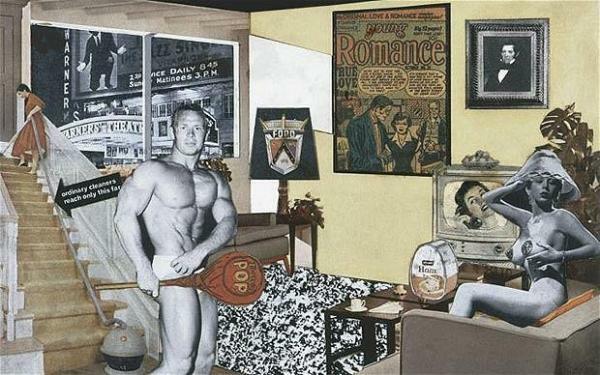
Jasper Johns (1930)
Jasper Johns meant for Pop Art in the USA, what R. Hamilton in the UK. Insatiable and restless artist, well known are his motifs of American flags, numbers and letters, and it is that, on him falls the merit of having introduced in American lands some purely popular images. As gallery owner Leo Castelli put it, "Jasper Johns must be considered the first truly American artist."
In works like Flag (1954) we notice his artistic talent when he takes a symbol of American identity so strong and that, nevertheless, it is posed to us with irony. At the same time, making use of (and showing off) the techniques of Abstract Expressionism, he makes a mockery of his predecessor movement.
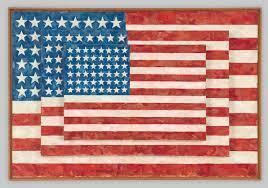
Robert Rauschenberg (1925 - 2008)
Robert Rauschenberg is a bridge figure between Neo-Dada and Pop Art. Although his work falls within the second, his work surprises by the multiple influences that the observer can appreciate. The most significant, without a doubt, his passion for marginal art, which he usually incorporates into his collages.
The most characteristic thing about his works is that they seem to want to highlight the waste of the materialistic world around you. In works such as Monogram (1955) or Coca-cola Plan (1955), Raushenberg does not represent what is new, but what is already used and consumed, creating a less ironic and more serious debate than his companions did.
But, it is well known that Rauschenberg's genius stood out in 1953 with the work Kooning drawing erased, when a very young Rauschenberg asked the, then God of contemporary painting, Kooning, to erase one of his favorite drawings. Perhaps, precisely because of that genius, a drawing of his (along with those of Warhol or Oldenburg) is presumably on the Moon.
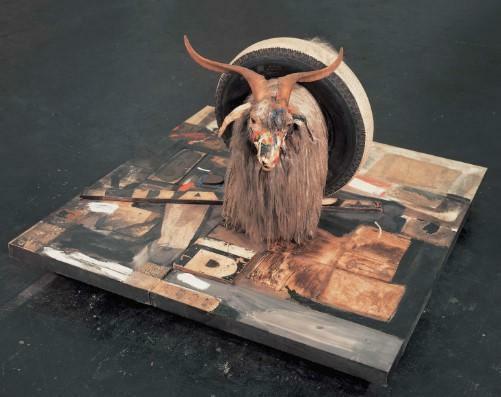
Roy Lichtenstein (1923-1997)
Roy Lichtenstein is, along with Andy Warhol, the Pop artist par excellence. Despite being an artist initiated into Abstract Expressionism, around 1958 his career took a turn towards figuration through the incorporation of images taken from the universe of the comics. Years later, his entire production consisted of icons from comics and television.
Lover of Picasso, in the production of it we notice a strong influence of cubism and collage technique, even though this was resolved only in the theoretical framework, since Lichtenstein's works were always works reproduced by hand following, yes, the technique of Benday of graphic arts.
Some of his most famous works are Kiss V (1964), Little Big Painting (1965), Arles Room (1992) or the Dance (1974), all of them currently considered as an outstanding mercantile value. And it is that over the years we can see how Lichtenstein's works achieve the status of what they imitate, an object of consumption.

Image: Saatchi Art
Tom Wesselman (1931 - 2004)
Tom Wesselman was another of the prominent artists of Pop Art and his works. He was a notable American Pop artist, whose leitmotiv it was the nude. But not just any nude, but the american nude, which consisted of the presentation of various female nudes brimming with eroticism and framed in scenes, often domestic, which were embedded in his canvases.
Claes Oldenburg (1929)
Claes Oldenburg was responsible for materializing the concept of object as monument by creating large-scale replicas of different everyday objects. In works like Spoonbridge and Cherry (1985-86), Free (1991) orApple core (1990) we observe pieces of soft sculptures that have been reinforced by fiber with polyester.
In turn, the thoughtful placement of Oldenburg's sculptures represents the appropriation of objects from consumption on public space, a metaphor, perhaps, of how these have ended up colonizing all of our scopes.

Image: ArtPeople. Net
David Hockney (1939)
Curious is the case of David Hockney, an artist who, despite constantly refusing to be considered a Pop artist, He is considered one of the greats within the movement. Originally from England, he moved to California in the late 1950s in search of a more relaxed and liberal environment.
It is precisely this carefree environment that we can visualize in works such as the famous The Biggesr Splah (1967), where by means of flat surfaces made with acrylics, Hockney presents us with the immediacy of the moment on a sunny terrace in California. The beauty of his work lies in the intrinsic anonymity, as well as in its impassive almost abstract planes.
Allen Jones (1937)
Being Allen Jones Founding Member of British Pop Art when participating in the exhibition Young Contemporaries (1961), his work continues to surprise by its high ability to shock the viewer, especially with regard to the fiberglass sculptural ensemble Hatstand, Table and Chair (1969). In it Jones creates an anthropomorphic furniture set and advocates through a radical figurativeism to the materialization of the sexual submission of women.
This representation transgresses the limits of what is politically correct to uncover the debate on how far the freedom of art can go when it comes to dealing with sexual identity roles. It was, is and possibly continues to be, especially for inexperienced eyes, a very complex work; surely that's why Stanley Kubrick decided to use them in his also controversial film A Clockwork Orange (1971).
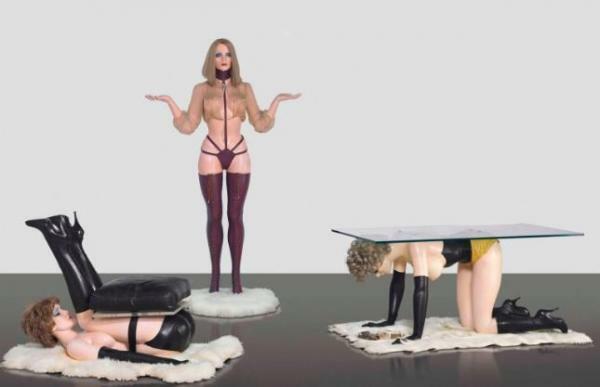
Andy Warhol.
Andy Warhol is the Pop artist par excellence, the artist who turned his name into a brand at the level and likeness of those icons that he represented in his works. Artist and product in himself, Andy Warhol cultivated a myriad of artistic techniques that ranged from the most conventional, such as painting or sculpture, to those most typical of their time, such as audiovisuals or the arts graphics.
Like many of his companions, through the use of the new reproduction techniques that his time had given her, she tried to create works that were alien to him. However, that superficiality is often blurred by the ironic play of his pieces. For example, in your SMao's erie From 1972 he mocks the communist leader by using repetition and colors.
This same strategy will be used repeatedly in his iconic Marylins Monroes or Lizs Taylors, although with them we notice a more affectionate and admiring treatment. Warhol reproduced what he longed for and that finally, after his The Factory or the creation of the magazine Interview, among many, many others, he succeeded.

If you want to read more articles similar to Pop Art: Featured Artists and Their Works, we recommend that you enter our category of Story.



